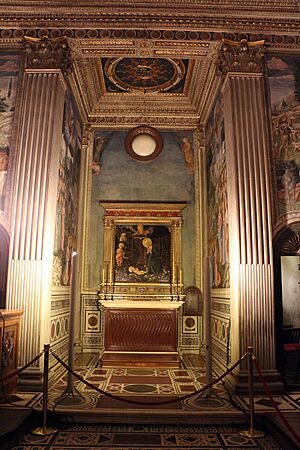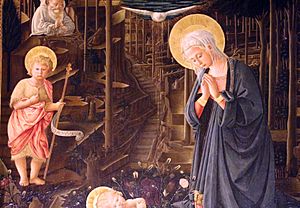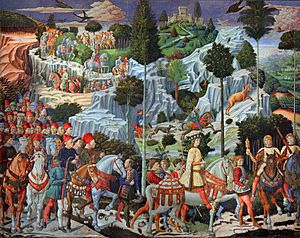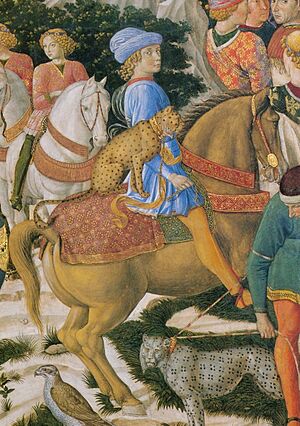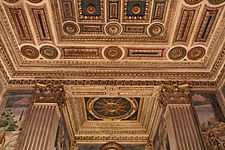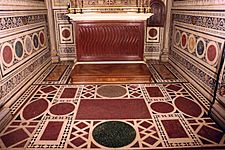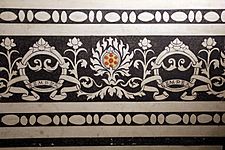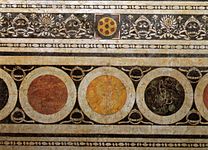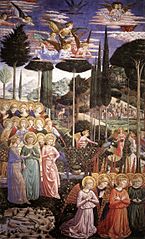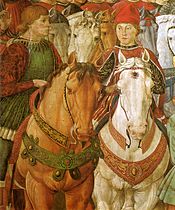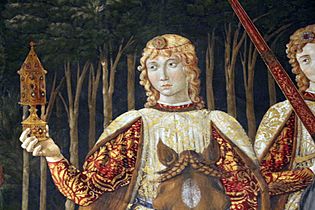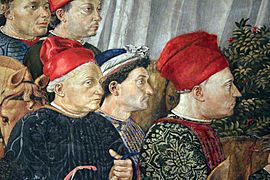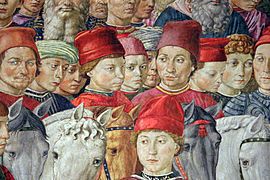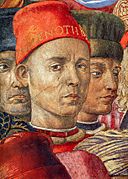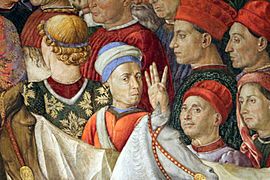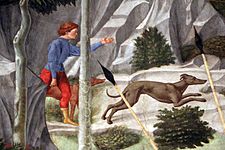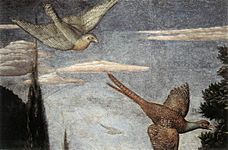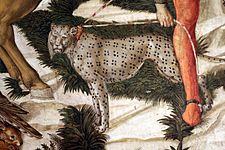Magi Chapel facts for kids
The Magi Chapel is a special room inside the Palazzo Medici Riccardi in Florence, Italy. Its walls are almost completely covered with amazing fresco paintings. These famous artworks were created around 1459 by a Renaissance artist named Benozzo Gozzoli. He painted them for the powerful Medici family, who were like the rulers of Florence at that time.
Contents
Discovering the Magi Chapel
This chapel is on the main floor of the palace, called the piano nobile. It was one of the first rooms to be decorated after the palace was finished. The building was designed by Michelozzo, a famous architect.
Originally, the chapel looked perfectly balanced. Its main entrance was through a central door, which is now closed. Inside, the chapel has two main parts: a large main room and a slightly raised area called an apse. This apse holds the altar and two small side rooms.
The chapel was started around 1449-1450 and likely finished by 1459. Its beautiful ceiling is made of inlaid wood, painted and covered in gold. This was done by Pagno di Lapo Portigiano, following Michelozzo's design. Michelozzo also designed the floor, which has a detailed pattern made from expensive stones like porphyry and granite. The Medici family wanted the chapel to look as grand as the old Roman basilicas and Florence's own Baptistery.
The first painting in the chapel was an altarpiece by Filippo Lippi called Adoration in the Forest. This original painting was sold in the 1800s and is now in Berlin. A copy made by one of Lippi's followers, Pier Francesco Fiorentino, is still in the chapel today.
The chapel is most famous for the wall paintings by Benozzo Gozzoli. In the raised apse, he painted Angels in Adoration. In the larger main room, he created the Journey of the Magi. This main room has three big frescoes, each showing the journey of one of the Three Magi. They are on their way to Bethlehem to see the birth of Jesus.
Gozzoli's paintings mix a religious story with pictures of important people from the Medici family. They also show their friends and some important figures who visited Florence for the Council of Florence (1438-1439). This meeting happened many years before the paintings were made. During the Council, the Medici family helped try to bring together the Catholic and Eastern Orthodox churches. The paintings show how fancy the Byzantine visitors were, which must have impressed the people of Florence at the time.
In the apse, the side walls show saints and angels praying. Gozzoli painted these in a style similar to his teacher, Fra Angelico. There are also three tall, thin fresco sections that show the shepherds from the nativity story.
Gozzoli's Amazing Journey of the Magi
How the Frescoes Were Made
Benozzo Gozzoli started painting in the spring or summer of 1459. He likely finished the work quickly, in just a few months, with help from at least one assistant. Piero di Cosimo de' Medici, the head of the Medici family, watched over the project. Piero probably suggested that Gozzoli use Gentile da Fabriano's Adoration of the Magi as an example for his frescoes.
Gozzoli used a very detailed painting method, mixing true fresco (painting on wet plaster) with dry fresco (painting on dry plaster). This allowed him to work very carefully, almost like an engraver. He had learned this skill when he worked as a goldsmith in Ghiberti's workshop. You can see his amazing craftsmanship in the tiny details. These include the jewels, fabrics, and horse harnesses. Even the trees full of fruit, the meadows covered in flowers, the colorful feathers of birds, and the angels' wings are incredibly detailed. To make the paintings shine in the dim candlelight, pure gold leaves were added generously.
The painting tells a religious story, but it also shows off a lot of fancy, worldly style. Angels sing and pray while the grand parade of the Three Kings travels towards Bethlehem. They are joined by their groups of followers. Along the way, they enjoy a noble hunting party with falcons and wild cats. The rich and varied costumes, with their princely details, make these paintings a fascinating look at art and fashion from that time.
The Famous Procession
Melchior, the oldest Magus, rides on the west wall, leading the procession. People often think he looks like Joseph, the Patriarch of Constantinople, who died in Florence during the Council. But he could also be Sigismund, Holy Roman Emperor, who helped end a big split in the church. Like Cosimo de' Medici, he is shown as a peacemaker, riding a donkey. A page in blue rides in front of him, with a leopard on his horse. This figure is a bit of a joke, representing Castruccio Castracani, a duke from Lucca. The leopard was a symbol of his family. Giuliano de' Medici is shown riding a white horse, with an African man carrying a bow in front of him.
Balthasar, the middle Magus, has a beard and rides a white horse on the south wall. He is painted to look like the Byzantine emperor John VIII Palaiologos. Some believe the three young women behind him are Piero's daughters: Nannina, Bianca, and Maria. Others think the faces of these young women are more likely among the other Medici family members shown.
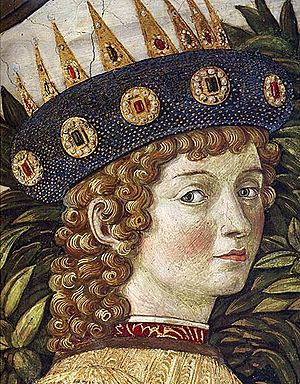
On the east wall, Caspar, the youngest Magus, rides a white horse at the end of the procession. This figure is often thought to be a perfect image of Lorenzo il Magnifico. Lorenzo was born in 1449, so he was still a boy when the fresco was finished. Right behind Caspar are the current head of the family, Piero the Gouty, on a white horse. Then comes the family's respected founder, Cosimo, riding a simple donkey.
After them are Sigismondo Pandolfo Malatesta and Galeazzo Maria Sforza, who were lords of Rimini and Pavia. They didn't attend the Council, but they were guests of the Medici family in Florence when the frescoes were painted. Following them is a parade of famous Florentines. These include thinkers like Marsilio Ficino and the Pulci brothers, members of the city's Art Guilds, and even Benozzo Gozzoli himself. The painter looks out at you, and you can spot him by the scroll on his red hat that says Opus Benotii (meaning "Work of Benozzo"). Young Lorenzo il Magnifico is the boy directly below Gozzoli, with a distinct snub nose. Lorenzo's younger brother, Giuliano, is next to him.
The rest of the painting shows rich Tuscan landscapes. This fresco was designed like the tapestries of the time, which were new and popular artworks for wealthy families. The fortress at the highest point of the picture looks like the Medici family's country home in Cafaggiolo, which Michelozzo also designed. This fortress is thought to represent Jerusalem, where the Magi's journey began. This was where King Herod had told the wise men to look for the child.
Piero de' Medici, who paid Gozzoli, felt that some of the angels were not quite right. He wanted them repainted. Even though the artist agreed, it was never actually done.
In 1659, the Riccardi family bought the Palazzo Medici. They made some changes to the building. In 1689, they built an outside staircase to reach the first floor. Because of this, the entrance to the chapel had to be moved. During this change, two sections of the wall were cut out of the southwest corner, right in the painting of the Oldest King's procession. After the stairs were finished, these cut-out pieces were put back on a corner of the wall that stuck out into the room. Because of this, the oldest king's horse was cut into pieces and placed on two different parts of the wall.
Gallery
- Interior
- Apse and altar
- Procession
-
Sigismondo Malatesta and Galeazzo Maria Sforza
- Medici and Gozzoli
- Nature
See also
 In Spanish: Cappella dei Magi para niños
In Spanish: Cappella dei Magi para niños
- Flagellation of Christ (Piero della Francesca) - another painting featuring contemporary portraits, the identities of which have been hotly debated.
- Adoration of the Magi (Sandro Botticelli) - a painting featuring prominent Medici family members as the Magi.
- Madonna of the Magnificat (Sandro Botticelli) - a painting featuring Lucrezia Tornabuoni, wife of Piero de' Medici, as Mary, while Lorenzo and Giuliano appear as angels.
- The Confirmation of the Rule (Domenico Ghirlandiao) - a painting featuring Lorenzo and his sons Giuliano, Piero and Giovanni, the latter being the future Pope Leo X.


